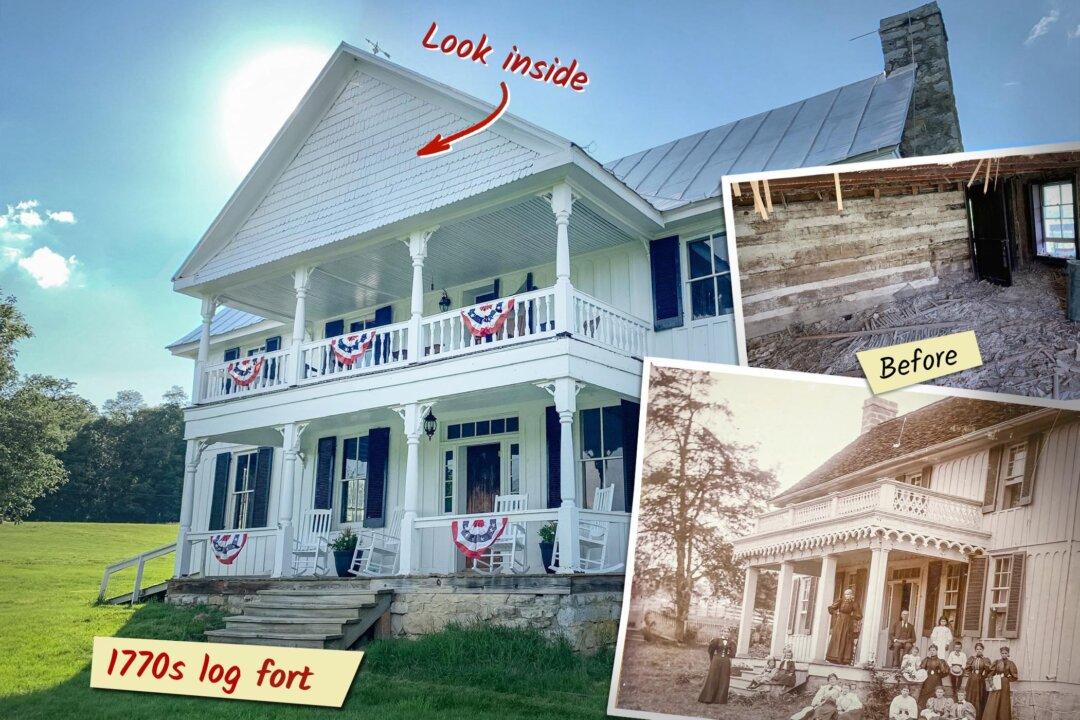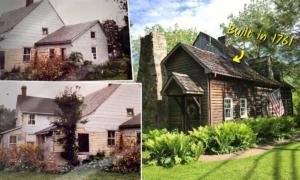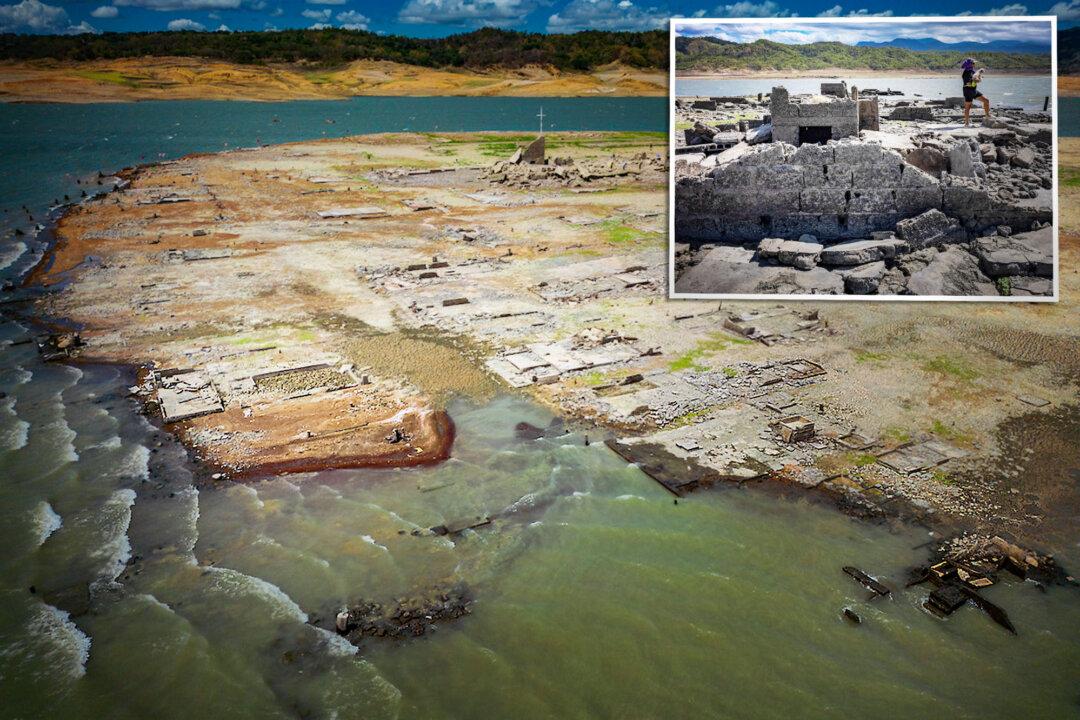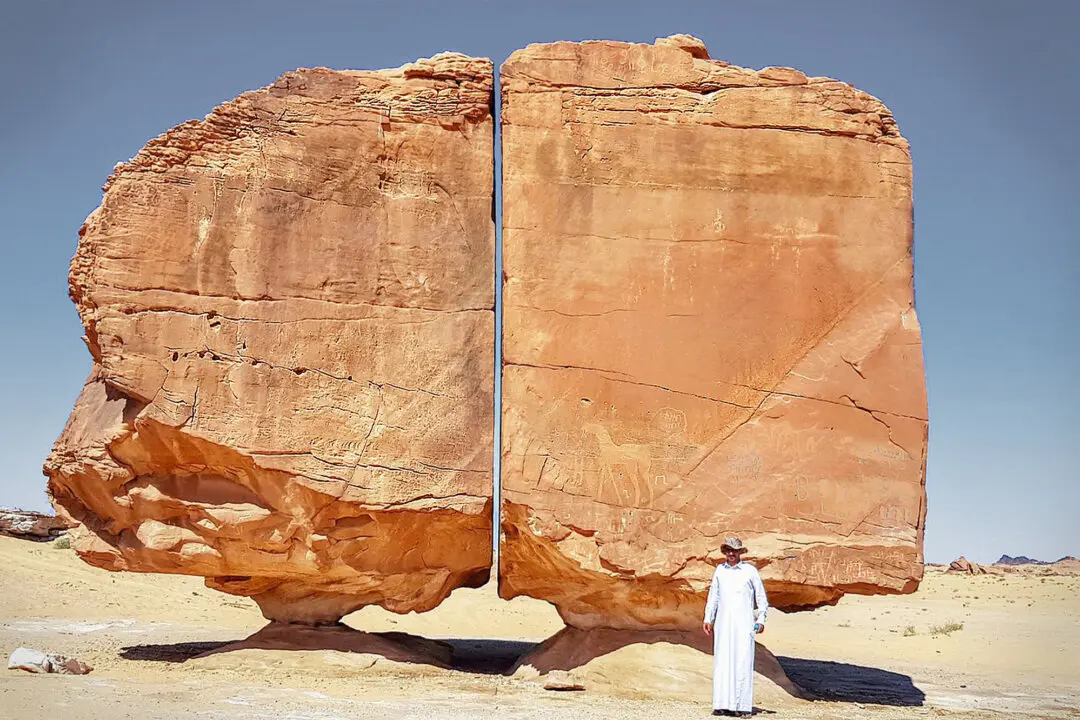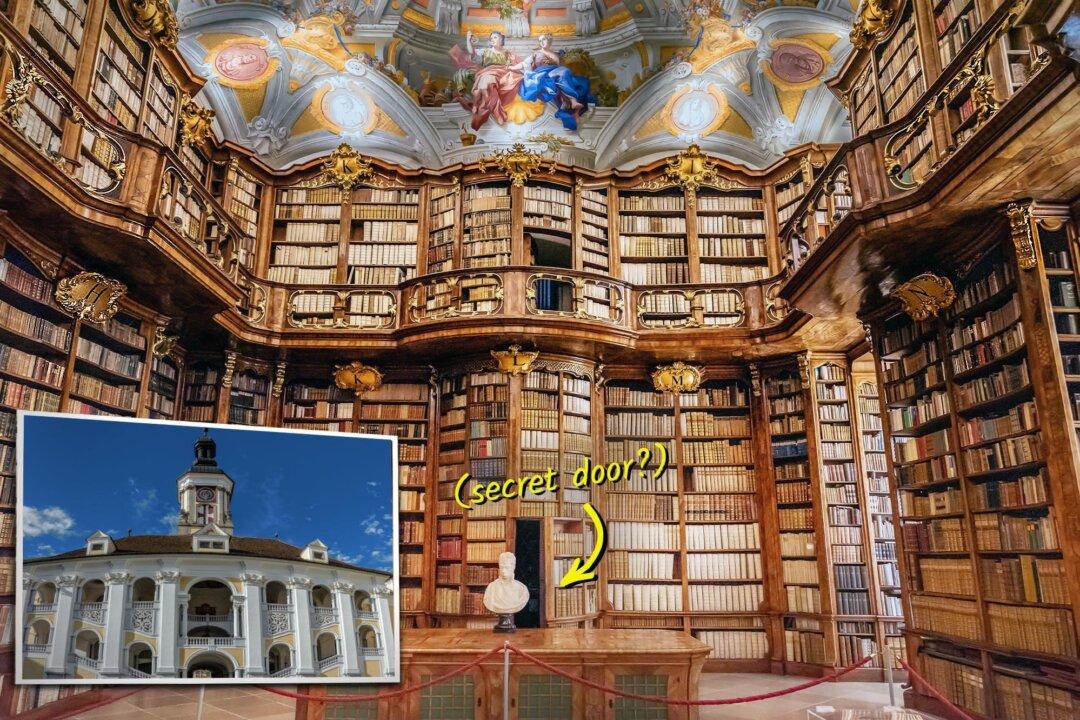You can still find a few rickety log cabins from the 1770s—America’s Revolutionary War period—in certain parts of West Virginia today.
More ambitiously, some archeologists since the 1980s have been scouring the soil in vain to find the large log fort of Daniel Boone, built in Kentucky in 1775. Yet none have succeeded.
Not even stains on the ground from the wood of the fort remain—let alone standing walls.
Just imagine, then, the gravity of what the attorney and history buff from West Virginia John Bryan, 43, witnessed upon puncturing the plaster walls of his newly-bought plantation house, back in April 2019, and finding a fort inside.
Taking a crowbar to the walls of the manor in Monroe County, near their home in Union, he and his wife saw them: The hewn log walls with big, hand-forged rose-head nails, and original chinking that looked like a primitive mixture of mud and horsehair.


This was the one and only Byrnside Fort, as seen in old sepia photos.
To be fair, historians had long suspected it rested there, in the bones of the old plantation house. Mr. Bryan himself reckoned as much, as it was already on the National Register of Historic Places.
“You couldn’t see any logs. But I was very confident they were there, just because it was consistent with [the history],” he told The Epoch Times.
Generations of families are known to have lived there continuously since the late 1700s, even connecting with the Founding Father James Burnside.
In 2019, an opportunity arose for Mr. Bryan to take possession when its owners, the Johnsons, who’d lived there since the Civil War, were left without an heir who wanted it.
Margaret Clark, a Johnson descendant, was the elderly owner who sold it to someone interested in farming the land. He in turn sold just the house and 5 acres to the Bryans for $75,000—a remarkable deal.
“The place itself was a treasure to me,” Mr. Bryan said.
The full-time attorney was intent on not allowing a national treasure to end up the lucrative plunder of builders picking out reclaimed logs for designer décor.
“The logs are even more valuable than the house,” he said. “I don’t want to see that place get just torn down for the logs.”
Out of a sense of duty, he would tackle a preservation project so it would last for future generations.

To say he was 100 percent certain it was actually there before they shelled out the cash would be false. He wagered it was. They confirmed the find 10 minutes after taking possession.
Byrnside Fort once stood tall in the deep frontiers of America. Virginia had been settled by mainly Irish and Scottish immigrants—many didn’t fear the very real threat of Indians at the time.
Those pioneers were stalwart, having endured travails in their ancestral homelands. They were intent on claiming this new and rich limestone land. Some were charged with manning forts to protect the settlers of Virginia.
Among Mr. Bryan’s myriad discoveries under the wall layers were gun loops and spy holes bored through the logs. These were meant for scouting out and opening fire on unwanted guests.
Fortifying the position further, stones were lodged tightly into the chinking, in between the logs—effectively bulletproofing the fort. The white oak itself was extremely stout.
There were other strategic aspects. Upon the hill where the fort stands, a stream flows from a cave. The settlers would have known this water source would sustain them in the event of a siege.
Evidence also shows that a stockade once abutted the walls of the fort, serving like a castle bastion, making raiders more vulnerable.
For Mr. Bryan, the excitement on revealing old scrawled names, dates, and math problems solved on the plaster was energizing.
“You wipe the dirt off it and you realize what it is, and [that] you’re the first person that’s touched that [in] many, many years,” he said, adding that he is amazed by what “surprises are hidden behind the plaster that nobody had seen since before the Civil War.”
Yet, despite his enthusiasm, he knew what a momentous task lay ahead: there would be thousands of manhours spent stripping back centuries of buildup to expose the log walls.


The house is big. Built for six original families, there are two full stories, a full basement, huge stone fireplaces, and an attic—in all, the fort measures 30 feet long, 20 feet deep, and 35 feet high.
Throughout the interior, the walls grew into a thick shell as ever more modern layers were added; Mr. Bryan had to strip them back to the core.
Beneath newer wallpaper, plaster was applied in 1858, covering the log walls and ceilings. What an ordeal removing this would be!
It was smeared on very thickly, mixed with animal hair atop a lattice of thin pieces of wood called “furring strips.” These were fastened to the original log walls using thousands upon thousands of tiny nails.
The nails had to be plucked one by one, the plaster scraped away painstakingly with a crowbar, forming mountains of debris and plumes of dust. And then there was the ceiling, which he called “the worst.”
The plaster is “nasty stuff,” Mr. Bryan said. “It kind of crumbles—halfway crumbles, halfway cracks, halfway turns into dust.”
In total, it took about two years to fully expose the original wall; all the plaster was gone by late summer 2021.
Besides the walls, more than two centuries of clutter had built up from generations of families living there.
Books dating from the 18th to 20th centuries populated the shelves, including, notably, an 18th-century copy of John Wesley’s sermons owned by a pastor-soldier, James Christy, stationed there during the Revolutionary War.
“He describes being garrisoned at Byrnside Fort pretty much every year of the war, guarding against basically the threat of any attack, protecting the local civilian population,” Mr. Bryan said, speaking of what his research uncovered.
While less valuable objects were tossed or donated, historic items were cherished like treasure.


In the yard outside the house, Mr. Bryan kept up a continuous excavation, using his metal detector to locate lost artifacts. From the soil, he produced heaps of hand-forged metal antiques.
There were pewter spoons, irons, knives, padlocks, silver coinage, buckles, and ornate old-fashioned keys. There were pieces he didn’t know what they were, and is still trying to identify.
The artifacts were heavily rusted and each had to be painstakingly preserved or face being lost to corrosion once exposed to the open air.
The project he had undertaken was simply mindboggling. Yet the rewards were astronomical, almost unfathomable.
From what he has learned about the fort, Mr. Bryan believes he grasps how it survived for so long, managing to outlive all the rest.
Most log cabins from that era were built rather small, were hastily raised, and would have fallen down fairly soon.
The key to its longevity may lie in its ownership, he said. Being a rather nice and big house in those days, it clearly had been well cared for by the families living there.
“It was a very, very large early structure,” Mr. Bryan said. “And I think because, for that reason, it was always going to be worth keeping.”
Since once the roof goes, the house goes, a “good roof” had always been kept during the decades and centuries—the house’s inhabitants apparently had means at their disposal.
One-inch-thick weatherboard was raised, encasing the whole cabin, allowing it to stay bone dry for centuries.
“It was continuously lived in because it was a comfortable house,” Mr. Bryan said. It was “continuously lived in from 1770 all the way through 2016.”
Further work had to be done on the house, though.
There were centuries worth of dust and grime that had gathered. Whitewash had also been applied—probably because, after some time, log walls were no longer considered something to be proud of.
The inhabitants had masked the eyesore with white paint.
In order to make it truly authentic, though, Mr. Bryan wanted to remove not just the grime, but the whitewash too. How could that be done?
After scoring most of it off by sanding and hand scrubbing, he heeded some advice from fellow restorers and power-washed the whole interior—peeling back layers, exposing the original white oak.
Had he and his wife planned to live there—which they aren’t—it would have gone on much longer; all the chinking would have needed clearing out.
Wanting to preserve the original artifacts as much as possible, though, all the loose chinking and packed stones were simply cleaned and left in place. The wood, of course, would stay.
Improvements were also made. The large gaps between the logs and chinking were filled with insulation and a modern chinking compound that Mr. Bryan concocted.



As for the exterior, the plantation house had been painted white in modern times. It looked the part of an old house in desperate need of a good paint job.
Once that was finished, Fort Byrnside was pretty much ready for what its new owners had in mind.
Mr. Bryan has shown the fort to like-minded historians and societies—including the Johnson family, who reached out to him.
The Johnsons have “come three times to tour the house and look through,” he said. “I feel almost like this is my own family, and I’m preserving their stuff. Even though I’m not related to [them], it’s kind of like my adoptive family.”
If Mr. Bryan has his way, Fort Byrnside will become a museum of sorts. All those fancy antique objects are now displayed. Although the bulk of the preservation is done, he admits the project is ongoing.
No doubt, this jewel of American Revolutionary history will rest among Mr. Bryan’s most notable legacies.
“I feel a sort of a responsibility to preserve this stuff for the future,“ he said. “It’s been like a calling for me, I view it as like a life’s work.”

